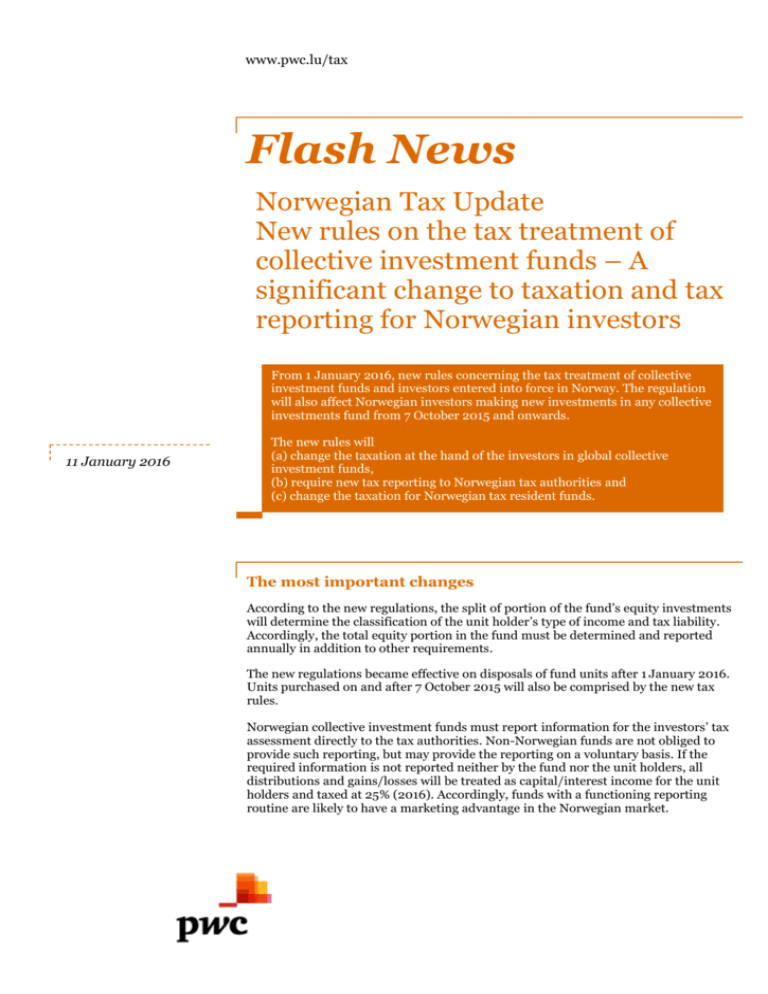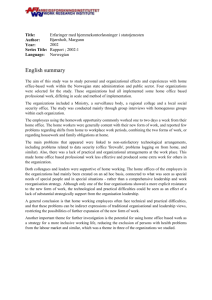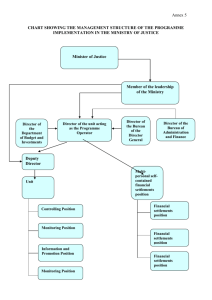
www.pwc.lu/tax
Flash News
Norwegian Tax Update
New rules on the tax treatment of
collective investment funds – A
significant change to taxation and tax
reporting for Norwegian investors
From 1 January 2016, new rules concerning the tax treatment of collective
investment funds and investors entered into force in Norway. The regulation
will also affect Norwegian investors making new investments in any collective
investments fund from 7 October 2015 and onwards.
11 January 2016
The new rules will
(a) change the taxation at the hand of the investors in global collective
investment funds,
(b) require new tax reporting to Norwegian tax authorities and
(c) change the taxation for Norwegian tax resident funds.
The most important changes
According to the new regulations, the split of portion of the fund’s equity investments
will determine the classification of the unit holder’s type of income and tax liability.
Accordingly, the total equity portion in the fund must be determined and reported
annually in addition to other requirements.
The new regulations became effective on disposals of fund units after 1 January 2016.
Units purchased on and after 7 October 2015 will also be comprised by the new tax
rules.
Norwegian collective investment funds must report information for the investors’ tax
assessment directly to the tax authorities. Non-Norwegian funds are not obliged to
provide such reporting, but may provide the reporting on a voluntary basis. If the
required information is not reported neither by the fund nor the unit holders, all
distributions and gains/losses will be treated as capital/interest income for the unit
holders and taxed at 25% (2016). Accordingly, funds with a functioning reporting
routine are likely to have a marketing advantage in the Norwegian market.
Taxation of the collective investment funds and unit holders
Taxation of Norwegian tax resident collective investment funds
Collective investment funds shall remain a separate tax subject and shall follow the
tax rules applicable to companies including benefit of the tax exemption method.
The taxation of the fund’s income will be based on the values of the underlying
investments. If the value of the equity investments based on the total value of the
fund less cash per 1 January each year exceeds 80% of the total investments, all net
income will be regarded as equity income and comprised by the tax exemption
method. If the equity portion is less than 20%, all of the fund’s net income will be
regarded as capital/interest income taxable at 25% tax rate (2016), with tax
deduction for distribution to the investors. If the equity portion is between 20% and
80%, the net income will be divided accordingly.
This means that funds will be able to minimise or avoid tax leakage by making
sufficient distribution of deductible interest income to the unit holders.
Taxation of the unit holders tax resident in Norway
Taxation of unit holders will depend on classification of income from the fund. The
classification will be defined as follows:
Distributions and gains/losses from collective investment funds where the
underlying investments less cash exceed 80% equity portion; will be taxed as
respectively as dividends and equity gain/losses.
Distributions and gains/losses from collective investment funds where the
underlying investments less cash are less than 20% equity portion will be
taxed as respectively interest income and capital gain/losses.
Distributions and gains/from collective investment funds where the
underlying investments less cash have an equity portion between 20 and
80% will taxed accordingly be based on the split respectively as dividend and
interest income calculated on a pro rata basis.
This means that unit holders mainly will be taxed as if they had made a direct
investment in the same instruments.
It will however still be possible to achieve a shift from interest income to share
income to a certain extent, by investing in collective investment funds with a portion
of interest bearing securities less than 20%. Under the 2015 rules, the similar effect
could however be achieved with interest income up to 99.9% for foreign
share/combination investment funds. Share income taxed under the exemption
method will be taxed as interest if the share portion is less than 20% of the fund. For
investors comprised by the Norwegian participation exemption method, the tax rate
on dividends is 0% while the rate is 25% on interest income (deduction for losses) in
2016. For personal investors the tax rate in 2016 is 28.75% on dividends and 25% on
interest income (deduction for losses at the same rate).
Calculation of the equity portion of the underlying investments in the fund
The equity portion shall be calculated by the ratio between the value of all assets less
cash divided by equity instruments (shares, participations in companies,
partnerships, funds etc.) and other securities (bonds, derivatives and other debt
instruments) at the beginning of the fiscal year (net asset value - NAV). The
calculation shall be based on the figures on 1 January each fiscal/calendar year.
Investments in other investment funds (“fund-in-fund”) are included in the
calculation if these funds are reporting to the Norwegian tax authorities. However, if
the underlying funds are not reported to the Norwegian tax authorities, the units held
in underlying funds shall be included in the calculation only if they amount to more
than 25% of the total value of the fund in question at the beginning of the fiscal year.
The calculation includes investments that are owned directly by the underlying fund
with a corresponding proportionate part. Investments that are owned by underlying
funds further down than one level in the ownership chain are not taken into account.
Only the portion of the investment’s input value corresponding to the equity portion
in the acquisition year provides the basis for calculation of tax exempt income shield
under the shareholder model for individual investors. Distributions that are taxed as
interest income are not tax exempt or treated as shielded income under the
participation exemption method and the shareholder model.
When an investment is realised, gains and losses are calculated under the ordinary
tax rules based on a first-in-first-out principle. For unit holders investing in funds
with other securities than shares, the tax exemption under the participation
exemption method is reduced pro rata calculated, based on the share portion in the
fund in year of realisation and the acquisition year. For shares acquired before 7
October 2015, the share portion for the acquisition year shall be calculated as 100%
shares.
Reporting obligations for Norwegian funds
Norwegian tax resident funds must annually report information to the tax authorities
that is necessary to determine the funds and the Norwegian tax resident investors tax
positions and tax effects. The information needed for the tax assessment in Norway is
very comprehensive and complex. Data must be collected based on the fund’s
investments on 1 January each year as well as each and every transaction between the
investor and the fund.
The data should contain correct information regardless of the location of the fund for
Norwegian tax resident investors:
(a) information about the fund in order to make the correct classification of the fund
in accordance with the Norwegian tax law,
(b) identification of the investor in accordance with the necessary specifications,
including classification as individual investor or corporate investor,
(c) calculation of the fund’s equity portion of the underlying investments 1 January
each year from 2016. For investments made before 7 October 2015, the equity
portion shall be set to 100% at 1 January 2016. For investments made 7 October 2015
to 1 January 2016, the equity portion is set to the portion at 1 January 2016,
(d) for each purchase and disposal of units and each distribution, and the tax effects
to the investors based on the classifications of the fund and investor, where a first-infirst-out principle applies, the effects of the relevant portion of the fund’s equity
portion of the underlying investments, and
(e) calculation of the participation units net asset value per 1 January each year.
Reporting obligations for Norwegian investors
Norwegian tax resident investors may rely on the reporting provided by the funds as
mentioned above. The same applies normally for data reported by non-Norwegian
funds.
In case the fund has failed to report to the Norwegian tax authorities, the investor is
required to provide the tax reporting on his own within a deadline of 31 March. If the
investor fails to report, the investment will be regarded as a bond investment. Penalty
taxes may also apply in specific cases.
Investments in Non-Norwegian investment funds
The new rules will also apply to Non-Norwegian investment funds although the
taxation in many cases will be different from Norwegian funds as this is Norwegianspecific tax rules.
Foreign funds do not have mandatory reporting obligations to the tax authorities in
Norway, but the Norwegian investor market will expect that either the foreign fund
provides voluntary reporting to the tax authorities or at least provides the correct and
exhaustive information that the investor can file to the tax authorities to achieve a
correct tax assessment.
In regards to the terms of reporting, it might be challenging to get access to sufficient
information and documentation about the split between the funds’ investments in
shares and other securities at the correct time as mainly Norwegian unit holders will
be interested in such information. However, for the Norwegian investors this
information will be crucial to obtain either from the fund directly or by the fund
reporting the information to the Norwegian tax authorities.
Differences between Norwegian and Non-Norwegian funds
The different situation between Norwegian and Non-Norwegian funds causes various
differences and challenges. The foreign funds will, to a large extent, be exempt from
tax liability (for instance in Sweden, Denmark, Ireland and Luxembourg);
accordingly there will not be any tax consequences for the fund as a result of
transactions or distributions. This in contrast to Norwegian collective investment
funds with interest income where distributions to unit holders must be carried out to
prevent taxable income in the fund.
This implies that there will still be a difference between Norwegian and foreign
funds, where the Norwegian fund must make distributions, while the foreign fund
may also accumulate interest income. This implies that certain foreign funds still will
have a favourable tax effect compared to Norwegian funds as the taxation of interest
income may be deferred when investing in foreign funds.
Conclusion
As a conclusion, the changes in the tax treatment of collective investment funds for
Norway provides a need to have detailed information with regard to the type of
investments made – equity or interest instruments – by funds having Norwegian
investors.
Actions to be taken
The new legislation was put into force from 1 January 2016. However, the investors
making new investments after 7 October 2015 will also need to have information
from this day onwards in order to calculate the ratio between share and interest
income at the time of the acquisition of the units.
Therefore, any action at fund or investor level should be evaluated as soon as
possible. Further, the funds should certify that the information needed can be
provided to the Norwegian tax authorities and/or its Norwegian investors.
For more information, please contact us:
…………………………………………………………………………………………………………………….
Dag Saltnes
Partner
+47 9526 0632
dag.saltnes@no.pwc.com
Bodil Marie Myklebust
Senior Manager
+47 9526 1323
bodil.myklebust@no.pwc.com
Oliver Weber
Partner
+352 49 48 48 3175
oliver.weber@lu.pwc.com
Oliver Schachinger
Partner
+352 49 48 48 2027
schachinger.oliver@lu.pwc.com
Marc Schernberg
Partner
+352 49 48 48 2142
marc.s.schernberg@lu.pwc.com
Laurent Garzino
Partner
+352 49 48 48 2018
laurent.garzino@lu.pwc.com
Carsten Brengel
Partner
+352 49 48 48 2187
brengel.carsten@lu.pwc.com
Michael Frigo
Partner
+352 49 48 48 3332
m.frigo@lu.pwc.com
…………………………………………………………………………………………………………………….
…………………………………………………………………………………………………………………….
…………………………………………………………………………………………………………………….
…………………………………………………………………………………………………………………….
…………………………………………………………………………………………………………………….
…………………………………………………………………………………………………………………….
…………………………………………………………………………………………………………………….
…………………………………………………………………………………………………………………….
PwC Luxembourg (www.pwc.lu) is the largest professional services firm in Luxembourg with 2,600 people employed from 58 different countries. PwC
Luxembourg provides audit, tax and advisory services including management consulting, transaction, financing and regulatory advice. The firm provides
advice to a wide variety of clients from local and middle market entrepreneurs to large multinational companies operating from Luxembourg and the
Greater Region. The firm helps its clients create the value they are looking for by contributing to the smooth operation of the capital markets and
providing advice through an industry-focused approach.
The PwC global network is the largest provider of professional services in the audit, tax and management consultancy sectors. We are a network of
independent firms based in 157 countries and employing over 208,000 people. Talk to us about your concerns and find out more by visiting us at
www.pwc.com and www.pwc.lu.
© 2016 PricewaterhouseCoopers, Société coopérative. All rights reserved. In this document, “PwC Luxembourg” refers to PricewaterhouseCoopers,
Société coopérative (Luxembourg) which is a member firm of PricewaterhouseCoopers International Limited (“PwC IL”), each member firm of which is a
separate and independent legal entity. PwC IL cannot be held liable in any way for the acts or omissions of its member firms.






